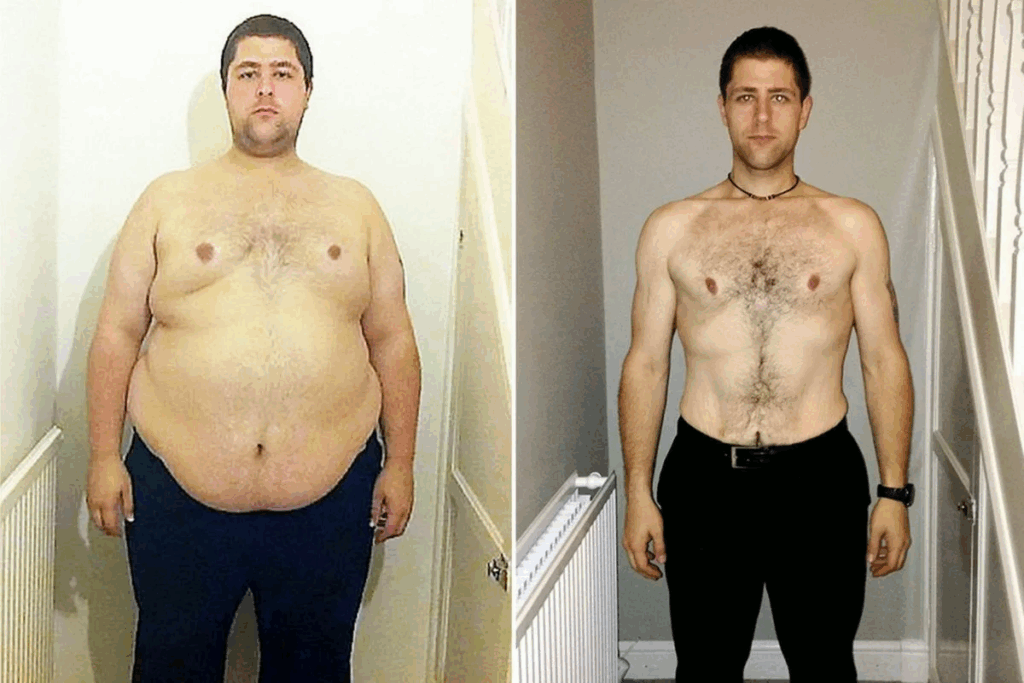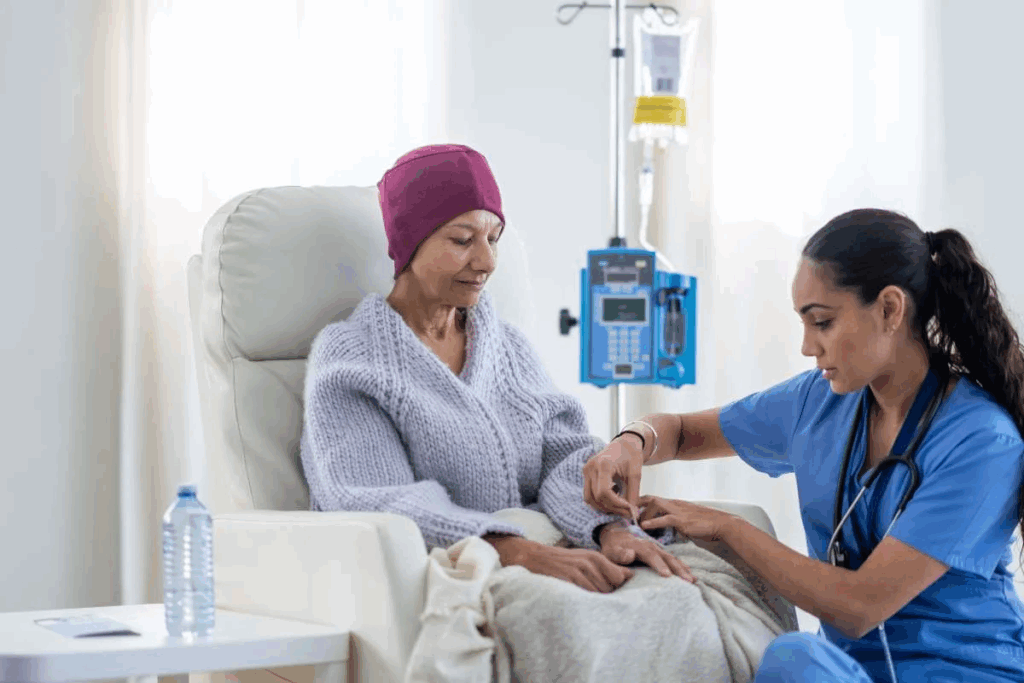Last Updated on October 21, 2025 by mcelik

Getting a cancer diagnosis is scary, and choosing whether to have chemotherapy before or after surgery is a big decision. This choice can really affect how well you do, how you recover, and your overall quality of life.Learn chemotherapy after surgery, including timing, pros, and cons for effective cancer treatment planning.
At Liv Hospital, our team is all about the latest research and putting patients first. We aim for the safest, most innovative, and best results for everyone.
Whether to have chemo before surgery or after depends on many things. Like what kind of cancer you have and how far it’s spread. Studies show that when you have chemotherapy matters a lot for how well you’ll do.

Chemotherapy timing is key in cancer care. It’s given at different stages, based on the cancer type, stage, and patient health. This decision is made with careful thought.
Neoadjuvant chemotherapy is given before surgery. It aims to shrink the tumor, making it easier to remove. Adjuvant chemotherapy is given after surgery. It targets any remaining cancer cells to lower the chance of cancer coming back.
Chemotherapy timing has changed a lot over time. At first, it was used only when all else failed. But now, it’s often used with surgery and other treatments. This change is thanks to new research and technology.
Chemotherapy’s main goal is to kill cancer cells. It’s used before or after surgery. It helps by shrinking tumors, getting rid of tiny cancer cells, and stopping cancer from spreading. The choice between neoadjuvant or adjuvant chemotherapy depends on the cancer and the patient’s health.

Deciding when to start chemotherapy is a big decision. It depends on many factors. Doctors look at these factors to plan the best treatment.
The type of cancer and its traits are key. Different cancers react differently to treatment. For example, some cancers grow fast and need quick treatment.
A study on PubMed Central shows how important the cancer type is. It greatly affects how well treatment works.
The size and stage of the tumor matter too. Big tumors or those that have spread might need chemotherapy first. This makes surgery easier later on.
Smaller tumors might be treated with surgery first. Then, chemotherapy is used to kill any cancer cells left behind.
Each patient’s health, age, and other conditions are also important. Some patients might not handle chemotherapy well. This could mean waiting to start treatment.
Doctors also consider what the patient wants. They make sure the treatment fits the patient’s needs and values.
“The key to successful cancer treatment lies in tailoring the approach to the individual patient’s needs and cancer characteristics.”
| Factor | Influence on Chemotherapy Timing | Example |
| Cancer Type | Different cancers respond differently to chemotherapy | Aggressive cancers like certain leukemias may require immediate chemotherapy |
| Tumor Stage and Size | Larger or more advanced tumors may require neoadjuvant chemotherapy | Tumors that have spread to lymph nodes may need chemotherapy before surgery |
| Patient Health | Overall health and comorbidities affect tolerance to chemotherapy | Patients with heart conditions may require adjusted chemotherapy regimens |
In conclusion, many factors influence when to start chemotherapy. These include the cancer type, tumor size, and the patient’s health. Doctors use this information to create personalized treatment plans.
Neoadjuvant chemotherapy is given before surgery. It has many benefits in cancer treatment. It can improve patient outcomes in several ways.
One key benefit is shrinking tumors. This makes them easier to remove. It leads to better surgical results, with more precise and less invasive procedures.
Neoadjuvant chemotherapy lets us see how well the cancer responds early. We can check the tumor’s reaction to chemotherapy before surgery. This gives us important insights into the treatment’s effectiveness.
Reduced tumor size can mean less extensive surgery. This preserves more healthy tissue. It can lead to better recovery and cosmetic results.
Another big plus is tackling micrometastases early. By targeting these tiny cancer cells before surgery, we can lower the chance of cancer coming back. This improves long-term survival chances.
In summary, neoadjuvant chemotherapy has many benefits. It improves surgical outcomes, lets us assess treatment early, and can lead to less extensive surgery. It also helps address micrometastases early. These advantages make it a key part of cancer treatment plans.
Neoadjuvant chemotherapy has shown promise in treating various cancers. But, it’s important to look at its drawbacks. This treatment approach has gained attention for improving surgical outcomes and survival rates. Yet, it comes with challenges and complications.
One major concern is the delay in surgery. For some, waiting can be a big problem, mainly if the cancer is aggressive. We must balance the benefits of preoperative chemotherapy with the risks of delaying surgery.
Neoadjuvant chemotherapy can lead to complications that might make surgery risky. Chemotherapy-induced toxicity can harm a patient’s health, increasing the risk of surgical complications. In some cases, this could make a patient ineligible for surgery, which is a significant drawback.
After neoadjuvant chemotherapy, assessing the tumor can be harder. The treatment can change the tumor’s characteristics, making it tough for pathologists. This can affect post-surgical treatment planning and prognosis.
Another concern is the risk of cancer progression during treatment. In some cases, the cancer may not respond to chemotherapy or could even get worse. This highlights the need for close monitoring and adjusting the treatment plan as needed.
Chemotherapy after surgery, called adjuvant chemotherapy, offers many benefits. It helps lower the chance of cancer coming back. This is because it kills any cancer cells left behind by surgery.
Surgery first means the immediate removal of the primary tumor. This brings relief by getting rid of the main cancer source. It also helps organs work better, depending on where the tumor was.
After surgery, the tumor is checked by pathologists. This leads to a more precise pathological staging of the cancer. Knowing the cancer’s extent helps plan the right treatment.
The findings from the tumor help create a targeted treatment plan. Knowing the tumor’s genetic makeup and receptor status lets doctors tailor the chemotherapy. This makes the treatment more effective.
Removing the primary tumor has big psychological benefits for patients. It lowers anxiety about the tumor. It also makes patients feel they’ve made a big step in their treatment.
Knowing what to expect during chemotherapy after surgery can help reduce anxiety. We’ll cover the key points of adjuvant chemotherapy. This includes the timeline, managing side effects, and the support available to you.
The start of adjuvant chemotherapy varies based on cancer type, surgery extent, and health. It usually begins a few weeks after surgery, once the patient has healed enough. It’s important to let the body heal before starting chemotherapy.
Recovery involves watching for surgery complications and checking blood counts. Our team will keep a close eye on your progress and adjust the treatment as needed.
| Week | Typical Activities | Recovery Milestones |
| 1-2 | Rest, wound care | Initial healing, pain management |
| 3-4 | Gradual increase in activity | Suture removal, improvement in mobility |
| 4-6 | Preparation for chemotherapy | Full recovery from surgery, readiness for chemotherapy |
Managing side effects is key during adjuvant chemotherapy. Common issues include fatigue, nausea, hair loss, and infection risk. Strategies like medication for nausea and rest for fatigue can help.
It’s important to talk to your healthcare team about any side effects. They can often adjust the treatment to lessen severe side effects.
Checking how well chemotherapy is working is important. This involves regular checks by your healthcare team. These may include imaging tests, blood work, and physical exams.
The frequency of these checks depends on your cancer type and treatment. Our team will create a personalized schedule for follow-ups and tests.
A strong support system is essential during chemotherapy. This includes family, friends, support groups, and counseling services. Cancer centers also offer nutrition counseling, psychological support, and rehabilitation services.
We encourage patients to use these resources to improve their well-being and treatment outcomes.
Adjuvant chemotherapy is a big help in cancer treatment but comes with big challenges. It’s used to kill any cancer cells left after surgery. But, figuring out when and how it works can be tricky.
One big problem with adjuvant chemotherapy is recovery issues that can slow down treatment start. After surgery, the body needs time to heal. Any problems can make starting chemotherapy later.
This delay can be a big deal for several reasons:
Another issue is missing out on benefits from chemotherapy before surgery. Giving chemotherapy before surgery can shrink tumors, making surgery easier or less needed. But, chemotherapy after surgery doesn’t offer these benefits.
Early assessment of treatment response is also lost with adjuvant chemotherapy. This early check can help decide on the best treatment plan, avoiding treatments that won’t work.
The mental toll of surgery followed by chemotherapy is big. The back-to-back treatments can be overwhelming, affecting patients’ mental health and life quality. The long treatment time can cause fatigue, anxiety, and depression, showing the need for strong support.
In summary, while adjuvant chemotherapy is important, it has its downsides. Knowing these challenges helps improve care and outcomes for patients.
Perioperative chemotherapy is a new way to treat cancer. It uses chemotherapy before and after surgery. This method aims to make chemotherapy more effective.
Perioperative chemotherapy uses chemotherapy before and after surgery. First, chemotherapy is given to shrink the tumor. Then, the tumor is removed surgically. After surgery, more chemotherapy is given to kill any cancer cells left behind.
Key components of perioperative chemotherapy include:
Some cancers respond well to perioperative chemotherapy. These include:
| Cancer Type | Response to Perioperative Chemotherapy |
| Breast Cancer | High response rates, even in aggressive subtypes |
| Esophageal Cancer | Improved survival rates with combined treatment |
| Osteosarcoma | Enhanced limb preservation and survival outcomes |
Studies show that perioperative chemotherapy improves survival. A study in a leading oncology journal found better overall survival rates. This was compared to chemotherapy given only before or after surgery.
“The integration of chemotherapy before and after surgery has revolutionized the treatment of various cancers, providing a more effective care plan.” –
Managing perioperative chemotherapy is complex. It requires careful planning and teamwork. This includes:
Understanding perioperative chemotherapy helps healthcare providers create personalized treatment plans. This optimizes patient outcomes.
In breast cancer care, we tailor the order of chemotherapy and surgery to each patient. We look at the cancer’s stage, hormone receptor status, and HER2 status. This helps us choose the best treatment plan.
Guidelines suggest a team approach for breast cancer treatment. This team decides the best order for chemotherapy and surgery. Neoadjuvant chemotherapy is often used for bigger tumors or higher risk patients.
The choice of when to use chemotherapy depends on the tumor and patient’s health. We talk with patients to make sure the treatment fits their needs and wishes.
Neoadjuvant therapy is key for breast cancer, helping those who can have breast-conserving surgery. It makes the tumor smaller before surgery. This can make surgery easier and reduce the need for mastectomy.
“Neoadjuvant chemotherapy can significantly improve the chances of breast-conserving surgery, reducing the risk of recurrence and improving patient outcomes.”
The hormone receptor and HER2 status of the tumor are very important. For hormone receptor-positive tumors, hormone therapy is often used. For HER2-positive tumors, targeted therapies are considered.
| Tumor Characteristic | Treatment Consideration |
| Hormone Receptor-Positive | Hormone Therapy |
| HER2-Positive | Targeted Therapies (e.g., Trastuzumab) |
| Triple Negative | Chemotherapy |
The main goal of breast cancer treatment is to improve outcomes and quality of life. We help manage side effects and address any concerns during treatment.
By personalizing breast cancer treatment, we can improve outcomes and quality of life. Our team is dedicated to providing full care and support throughout treatment.
Timing is everything when it comes to chemotherapy for esophageal and gastrointestinal cancers. New protocols are bringing hope. These cancers are complex, so treatment must consider the cancer type, stage, and patient’s health.
Esophageal cancer treatment has made big strides, with chemotherapy being key. Neoadjuvant chemotherapy, given before surgery, has shown to improve outcomes for patients with advanced disease.
Neoadjuvant chemotherapy in esophageal cancer offers several benefits:
Colorectal cancer treatment depends on the tumor’s stage and location. Chemotherapy can be given before or after surgery, based on the case.
For rectal cancer, neoadjuvant chemoradiation is often used to shrink the tumor before surgery. This can improve surgical outcomes and lower the risk of recurrence.
Pancreatic cancer is tough to treat, with surgery being the only cure. Chemotherapy is often used with surgery, either before or after.
Neoadjuvant chemotherapy in pancreatic cancer is becoming more common. It helps identify patients most likely to benefit from surgery.
Chemotherapy’s impact on survival and quality of life varies among gastrointestinal cancers. For esophageal cancer, neoadjuvant chemotherapy has been shown to improve survival.
| Cancer Type | Common Chemotherapy Approach | Survival Benefit |
| Esophageal Cancer | Neoadjuvant Chemotherapy | Improved Overall Survival |
| Colorectal Cancer | Adjuvant or Neoadjuvant Chemotherapy | Reduced Risk of Recurrence |
| Pancreatic Cancer | Neoadjuvant or Adjuvant Chemotherapy | Variable Survival Benefit |
In conclusion, treating esophageal and gastrointestinal cancers with chemotherapy is complex. Understanding each cancer’s nuances and chemotherapy’s role helps healthcare providers tailor treatments. This approach improves patient outcomes.
Doctors decide when to start chemotherapy by working together. They look at all parts of a patient’s health. This way, they make sure chemotherapy is the right choice at the right time.
We have a team that decides the best treatment for each patient. This team includes doctors like oncologists and surgeons. They all work together to make the best decision.
| Specialist | Role in Decision-Making |
| Oncologist | Provides expertise on chemotherapy and cancer treatment |
| Surgeon | Assesses the feasibility of surgical intervention |
| Radiologist | Interprets imaging studies to assess tumor characteristics |
| Pathologist | Examines tissue samples to determine cancer type and stage |
Chemotherapy isn’t always the best choice. Doctors make this decision based on many factors.
We look at many things when deciding. This includes the patient’s health and any other health issues. Patient health is a critical determinant in deciding whether chemotherapy is appropriate.
We listen to what patients want. This way, patients are part of the decision-making. Effective communication between patients and doctors is key.
Personalizing chemotherapy timing is key for effective cancer treatment. We’ve looked at how different factors affect when to give chemotherapy before or after surgery. These include the type and stage of cancer, and the patient’s health.
Each patient’s needs should guide the timing of their chemotherapy. This means weighing the benefits and risks of giving chemotherapy before or after surgery. By doing this, doctors can tailor treatments to improve outcomes and quality of life.
Personalizing chemotherapy means looking at many factors. These include the cancer’s biology, the patient’s health, and what the treatment aims to achieve. This approach helps doctors make better decisions about when to give chemotherapy. It leads to treatments that are more effective and focused.
By focusing on individualized treatment, we can make cancer care better for everyone. As cancer treatment keeps getting better, making chemotherapy fit each patient’s needs will stay important. It’s a key part of giving top-notch care to patients.
Choosing between chemotherapy before or after surgery depends on many things. These include the cancer type and stage, tumor size, and the patient’s health. We look at these factors to decide the best treatment order.
Neoadjuvant chemotherapy is given before the main treatment, usually surgery. It aims to shrink the tumor and improve surgery results.
Neoadjuvant chemotherapy has several benefits. It can shrink tumors, improve surgery outcomes, and assess treatment response early. It may also lead to less extensive surgery.
Adjuvant chemotherapy is given after surgery. It aims to kill any remaining cancer cells and lower the chance of cancer coming back.
Adjuvant chemotherapy has several advantages. It removes tumors right away, allows for precise cancer staging, and targets treatment based on surgery findings. It also offers psychological benefits from removing the primary tumor.
Yes, chemotherapy can be given before and after surgery. This approach, called perioperative chemotherapy, is used for some cancer types. It has shown to improve survival in certain cases.
Chemotherapy timing is decided by a team of experts. They consider the cancer type, stage, and the patient’s preferences.
Yes, chemotherapy might not be recommended in some cases. This includes early-stage cancer or when the patient’s health is not good enough for chemotherapy.
Patient preferences are very important. We work closely with patients to understand their concerns. We then include their preferences in the treatment plan.
During chemotherapy after surgery, you can expect a typical recovery process. You will also need to manage side effects, monitor treatment success, and have access to support and resources.
Chemotherapy is mainly used for cancer treatment. But, it can also be used for other conditions. Its use depends on the specific medical situation.
Chemotherapy works for many cancer types. But, its success can vary. It depends on the cancer stage, type, and individual patient factors.
In some cases, chemotherapy can be used alone or with other treatments like radiation. This depends on the cancer type and stage.
Chemotherapy is a strong treatment meant for diagnosed medical conditions. Taking it without cancer can cause serious health problems.
Chemotherapy is used at different stages for different goals. It can shrink tumors before surgery, kill remaining cells after surgery, or manage advanced cancer.
Subscribe to our e-newsletter to stay informed about the latest innovations in the world of health and exclusive offers!
WhatsApp us